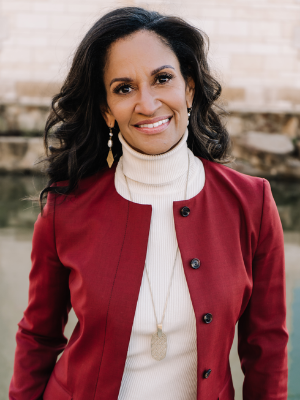 Christine Fritz, Portfolio Manager, PGIM, Germany, highlights how inclusive leadership helps women overcome hurdles in their careers.
Christine Fritz, Portfolio Manager, PGIM, Germany, highlights how inclusive leadership helps women overcome hurdles in their careers.
Though she’s lived in Europe for more than 25 years—15 of those in Munich, Germany—and speaks three languages, Christine Fritz credits her upbringing in the New York City suburbs with shaping the attitude she’s brought to her 20-year career in real estate.
“American education puts a lot of emphasis on creativity and taking a broad view of things,” she says. “Being outspoken and authentically you is encouraged. I bring that approach to my team by encouraging everyone’s diverse strengths.”
Fritz is co-portfolio manager of PGIM Real Estate’s European core equity strategy, responsible for a key part of the asset manager’s nearly $15 billion in assets under management and administration in Europe. The strategy invests in high-quality, income-producing properties across the logistics, prime office, residential, senior and student housing sectors throughout Germany, France, Italy, the Netherlands and the United Kingdom.
For International Women’s Day, Fritz spoke about her role at PGIM, her career, and why it’s important to create and support an environment of diversity and inclusion in the workplace and beyond.
Success requires diverse thinking
Throughout a tough real estate cycle, her team’s focus has been on growing the European core strategy’s income by increasing rental income, working with on-the-ground property managers and keeping tenants happy. That approach has seen success—the strategy has an over 96% occupancy rate and was responsible for 15% of all logistics leases signed in the German capital, Berlin, last year.
An important part of that is understanding what makes real estate assets more attractive.
“Real estate is about living and working, but also about the places in between,” Fritz says. “Designing places and looking at investments with the safety and comfort of the whole population in mind allows us to make a positive impact and make better investments.”
She quotes Danish architect Jan Gehl, “If you design places for 2-year-olds and for 82-year-olds, you will achieve the best possible result for all ages.”
Fritz says that in real estate, diversity of perspectives is vital to selecting successful investments across different countries and asset classes.
“Trends will often start in one location and then move to other countries,” she says. “If you talk to different people, you can get a broad perspective of how things are moving and use that information to predict how things might move in the future.”
Surviving the balancing act
Diverse, however, didn’t describe the work environment Fritz encountered early on in her career at a different firm.
“All my colleagues at the time were male,” Fritz says. “They were all going to meet up with the brokers to play soccer together. It didn’t occur to anyone to invite me, even though I played soccer in school.”
Many times, the slights were much more subtle—and Fritz doesn’t doubt that many of her colleagues were simply unaware of them. But returning from maternity leave after the birth of her first child, she saw just how insidious such behaviors could be.
The office was mostly empty by 6:30 p.m., but Fritz received pushback for leaving at 6 p.m. to be home with her child. The culture at the firm didn’t encourage speaking up about it.
“People treated me like I was working part time. They even made jokes about it,” she says. “It didn’t matter how many women had the same issue. It didn’t exist.”
Change begins with speaking up and leadership that listens.
Fritz says the environment at her current employer is far different.
When Fritz joined PGIM three years ago, the real estate industry was entering a crisis. The pandemic and remote work were decimating the office space market, and after Russia invaded Ukraine, central banks throughout the world began fighting inflation with increasing interest rates, causing values to fall.
Yet Fritz noted PGIM Real Estate remains committed to its diversity, equity and inclusion initiatives. One of them was PGIM Real Estate’s Inclusion Leadership Network, a global grassroots organization focused on driving culture change and inclusion by building awareness and removing hurdles in the careers of under-represented groups, whether based on race, gender, sexual orientation, socio-economic background, or disability. Focused on moving the needle on a local level, the ILN also has quarterly virtual meetups including colleagues from all over the world, to discuss challenges faced in the workplace, improve networking and career opportunities, and help the business change for the better.
Fritz was encouraged by leadership to join the network and become one of its co-leads in Europe.
“The senior management here really sees the business case behind this,” Fritz says.
Listening to colleagues from different backgrounds across different functions gave Fritz a broader perspective on what it meant to create a truly inclusive culture.
“I’ve learned about the challenges faced by people with different backgrounds and life experiences, about my own privilege and blind spots,” Fritz says. “I’ve learned about all the hurdles I haven’t had to jump over.”
Since Fritz joined, the Inclusion Leadership Network in Germany has hosted breakfast networking sessions, at a time the group finds most convenient for working parents who may need time to drop their kids off at school.
“Being able to talk openly about where the gaps are, and have people listen, is a massive improvement over what I’d seen before in the industry,” Fritz says.
Now a mom of two—a six- and a 10-year-old—when she speaks with other women in the field, Fritz emphasizes that keeping one’s authenticity amidst the challenges is key to a successful career.
“I don’t want anyone to think that it’s always easy or that you have to be a superhero to manage it,” she says. “What really matters to you? Finding a way to balance your priorities means talking openly about the trade-offs that you want or have to make.”
Contributed by PGIM Real Estate







